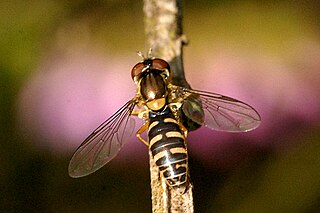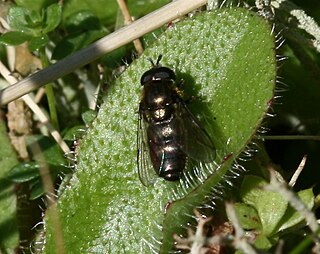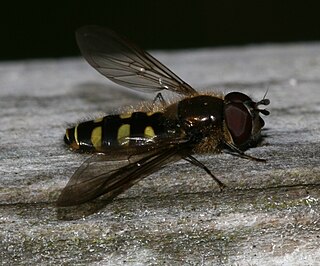Related Research Articles

Platycheirus clypeatus is a species of hoverfly. It is found across the Palearctic and in the Nearctic. The larvae feed on aphids. Adults are usually found on the edges of woodland or scrub, heath or along hedgerows where they visit a wide range of flowers.

Platycheirus is a large genus of hoverflies.

Sphaerophoria is a genus of hoverflies.

Sphaerophoria fatarum is a European species of hoverfly.

Chrysogaster solstitialis is a European species of hoverfly.

Platycheirus occultus is a Palearctic species of hoverfly.

Brachyopa is a Holarctic genus of hoverflies whose grey and brown colouration is unusual for this family and these flies can easily be overlooked amongst members of other fly families. The larvae can be found under the bark of dead branches and trees in decaying sap.

Pipizella is a genus Hoverflies, from the family Syrphidae, in the order Diptera.

Melangyna lasiophthalma is a Holarctic species of hoverfly.

Platycheirus angustatus is a species of hoverfly. It is found in many parts of the Palearctic, and in the Nearctic.
Platycheirus europaeus is a Palearctic species of hoverfly. It is found in many parts of Europe and eastern Asiatic Russia The habitat is brook floodplains and wet flushes in montane grassland and beside streams or flushes in forest in the Carpinus and Quercus zone up into the Fagus and Picea/ Pinus zone.Flies among grasses from May to August.Flowers visited include Graminae and Cyperaceae, Ranunculus, Taraxacum.
Platycheirus ramsaerensis is a Palearctic species of hoverfly. It is found along the parts of northern Europe that face the Atlantic. It is a member of the Platycheirus clypeatus group

Megasyrphus is a genus of hoverflies in the subfamily Syrphinae. It was formally a subgenus of Eriozona.
Eumerus sogdianus is a species of Hoverfly, from the family Syrphidae, in the order Diptera.
Dasysyrphus pauxillus is a North American and European species of hoverfly.
Sphaerophoria batava is a Palearctic hoverfly. Identification is problematic and this species is little known.
Sphaerophoria loewi is a Palearctic hoverfly. Identification is problematic and this species is little known.
Sphaerophoria rueppelli is a Palearctic hoverfly. Identification is problematic and this species is little known.

Mallota cimbiciformis is a Palearctic hoverfly.
References
- ↑ Goeldlin de Tiefenau, P. (1989). "Sur plusieurs especes de Sphaerophoria (Dipt., Syrphidae) nouvelles ou meconnues des regions palearctique et nearctique". Mitteilungen der Schweizerischen Entomologischen Gesellschaft. 62: 41–66.
- ↑ Stubbs, A.E.; Falk, S.J. (2002). British hoverflies, an illustrated identification guide (Second ed.). Reading: British Entomological and Natural History Society. pp. 1–469. ISBN 978-1899935055.
- ↑ Plant, Colin. W. (1990). "Sphaerophoria bankowskae Goeldlin, 1989 (Syrphidae) recorded in mainland Britain" (PDF). Dipterists Digest. First Series. Dipterists Forum. 3: 32–33. Retrieved 2 July 2015.
- ↑ Speight, Martin C.D. (1989). "Sphaerophoria fatarum in the British Isles (Syrphidae)" (PDF). Dipterists Digest. First Series. Dipterists Forum. 2: 34. Retrieved 2 July 2015.
- ↑ Van Veen, M.P. (2004). Hoverflies of Northwest Europe, Identification Keys to the Syrphidae (Hardback). Utrecht: KNNV Publishing. p. 254. ISBN 90-5011-199-8.
| | This hoverfly article is a stub. You can help Wikipedia by expanding it. |